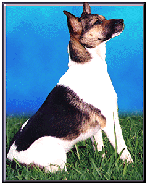Breed: Tenterfield Terrier
Temperament: friendly and very active
Lifespan: 12-14 years
Recommended for: families
Maintenance: low
Appearance: This is a small, smooth-coated terrier whose legs are in proportion to their body. Most have their tails docked. They stand 27cm (10.5″) and weigh around 5kg (10lb). Colours are black and white, tan and white, and black, tan and white. While sometimes confused with the Jack Russell, the Tenterfield Terrier has a finer build and a slightly arched skull.
Temperament: Owners say these dogs are active, bright, outgoing, loyal, curious and bold – the latter sometimes to their cost (see Health). They will adapt to life with a houseful of kids, or as a companion for an older adult. Burke’s Backyard recommends them as among best dog breeds for children.
Health and lifespan:
Luxating patellas (slipping kneecap). Any dogs used for breeding must obtain a vet check to ensure that they don’t have obvious signs of luxating patellas Curiosity gets them into more than their fair share of trouble, such as snakebite, poisoning by rat and snail bait, car hits and dog fights. They can get plump if indulged too often. Usually live for 12-14 years, but can live up to 20.
Useful qualities: While primarily a companion dog, most would sound the alarm at strangers but are not big enough to be guard dogs.
Space and exercise: Most Tenterfields get enough exercise running around the backyard but will benefit from a walk – provided they accept the leash! They will adapt to most situations, from farms to flats.
Training: Tenterfields require extra patience and persistence when it comes to training. Teach them the basics in fun, short 10 minute bursts with plenty of lavish praise for appropriate behaviour. Ignore bad behaviour, especially if it looks like an attention-seeking stunt. Some individual dogs have been difficult to house train and be inclined to cringe for no reason.
Breeding and cost: Litters of three and four are common and larger litters risk eclampsia in bitches. Few birth problems are known. The price for puppies start from $200.
History: Small Fox Terrier-like dogs have been known in Australia for at least 130 years. The Tenterfield terrier was first known and bred around the Tenterfield area – hence the name suggested by Don Burke. They were originally bred as farm dogs but about 10 years ago enthusiasts began to rally to develop breed standards with the long term view of applying for purebred status by canine bodies across Australia. There are about 1600 Tenterfield Terriers now registered with breed clubs.
National contacts
To find up-to-date contacts for breeders, contact the following organisations.
Dogs NSW
http://www.dogsnsw.org.au/breeders-directory
Email: [email protected]
Phone: 1300 728 022 (NSW only) or (02) 9834 3022
Fax: (02) 9834 3872
Dogs Victoria
http://www.vca.org.au
Email: [email protected]
Phone: (03) 9788 2500
Fax: (03) 9788 2599
Dogs ACT
http://www.actca.asn.au
Email: [email protected]
Phone: (02) 6241 4404 – Fax: (02) 6241 1129.
Dogs West
http://www.cawa.asn.au
Email: [email protected]
Phone: (08) 9455 1188
Fax: (08) 9455 1190
Dogs SA
http://dogssa.com.au
Phone: (08) 8349 4797
Canine Control Council of Queensland
http://www.cccq.org.au
Email: [email protected]
Phone: (07) 3252 2661
Fax: (07) 3252 3864
Tasmanian Canine Association
http://www.tasdogs.com
Email: [email protected]
Phone: (03) 6272 9443
Fax: (03) 6273 0844
Dogs NT
http://www.territorydogworld.com
Email: [email protected]
Phone: (08) 8984 3570
Fax: (08) 8984 3409



